Management Accounting Report: Prime Furniture Ltd Financial Strategies
VerifiedAdded on 2021/02/19
|19
|5063
|18
Report
AI Summary
This report delves into the realm of management accounting, focusing on Prime Furniture Ltd. It explores the core concepts of management accounting, encompassing financial, cost, and tax accounting, with practical examples. The report details various methods used in management accounting reporting, including budget reports, job cost reports, and inventory management systems. It also examines the benefits of different accounting systems and the integration of management accounting reporting. The report further analyzes financial statements prepared using both absorption and marginal costing methods, providing interpretations of case studies related to financial planning tools. The report concludes by comparing how organizations adapt management accounting systems to address financial problems, offering a comprehensive overview of the subject matter.
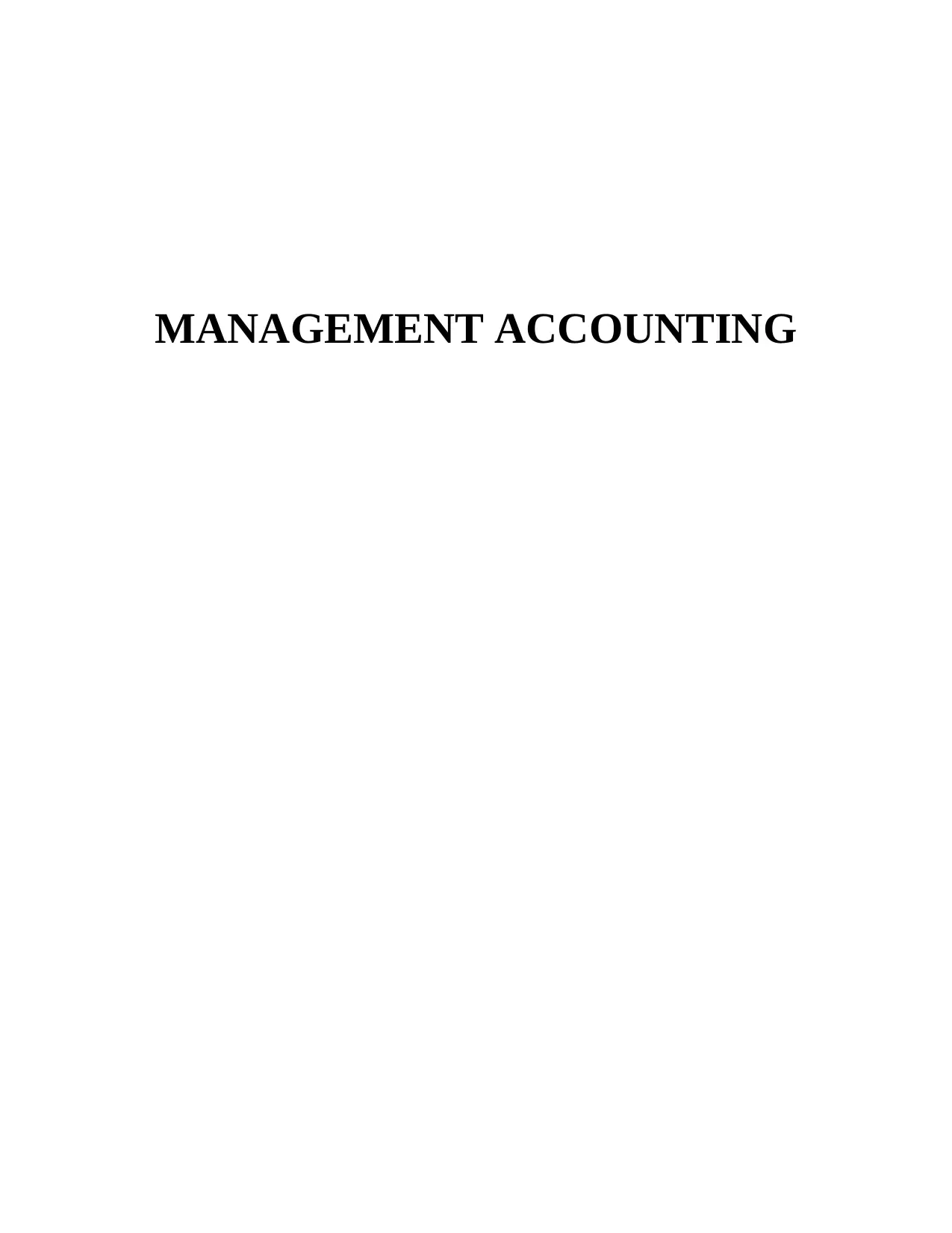
MANAGEMENT ACCOUNTING
Paraphrase This Document
Need a fresh take? Get an instant paraphrase of this document with our AI Paraphraser
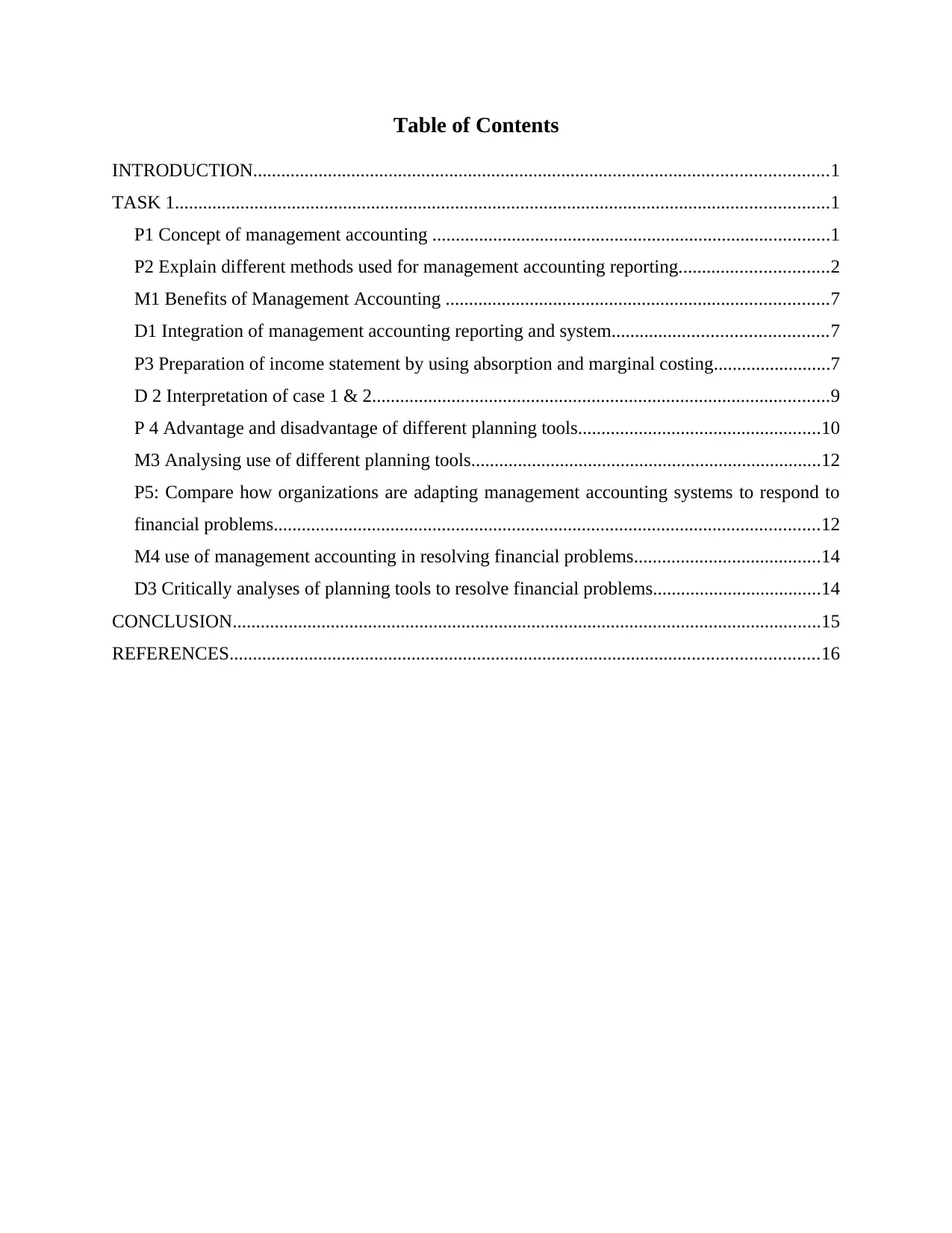
Table of Contents
INTRODUCTION...........................................................................................................................1
TASK 1............................................................................................................................................1
P1 Concept of management accounting .....................................................................................1
P2 Explain different methods used for management accounting reporting................................2
M1 Benefits of Management Accounting ..................................................................................7
D1 Integration of management accounting reporting and system..............................................7
P3 Preparation of income statement by using absorption and marginal costing.........................7
D 2 Interpretation of case 1 & 2..................................................................................................9
P 4 Advantage and disadvantage of different planning tools....................................................10
M3 Analysing use of different planning tools...........................................................................12
P5: Compare how organizations are adapting management accounting systems to respond to
financial problems.....................................................................................................................12
M4 use of management accounting in resolving financial problems........................................14
D3 Critically analyses of planning tools to resolve financial problems....................................14
CONCLUSION..............................................................................................................................15
REFERENCES..............................................................................................................................16
INTRODUCTION...........................................................................................................................1
TASK 1............................................................................................................................................1
P1 Concept of management accounting .....................................................................................1
P2 Explain different methods used for management accounting reporting................................2
M1 Benefits of Management Accounting ..................................................................................7
D1 Integration of management accounting reporting and system..............................................7
P3 Preparation of income statement by using absorption and marginal costing.........................7
D 2 Interpretation of case 1 & 2..................................................................................................9
P 4 Advantage and disadvantage of different planning tools....................................................10
M3 Analysing use of different planning tools...........................................................................12
P5: Compare how organizations are adapting management accounting systems to respond to
financial problems.....................................................................................................................12
M4 use of management accounting in resolving financial problems........................................14
D3 Critically analyses of planning tools to resolve financial problems....................................14
CONCLUSION..............................................................................................................................15
REFERENCES..............................................................................................................................16
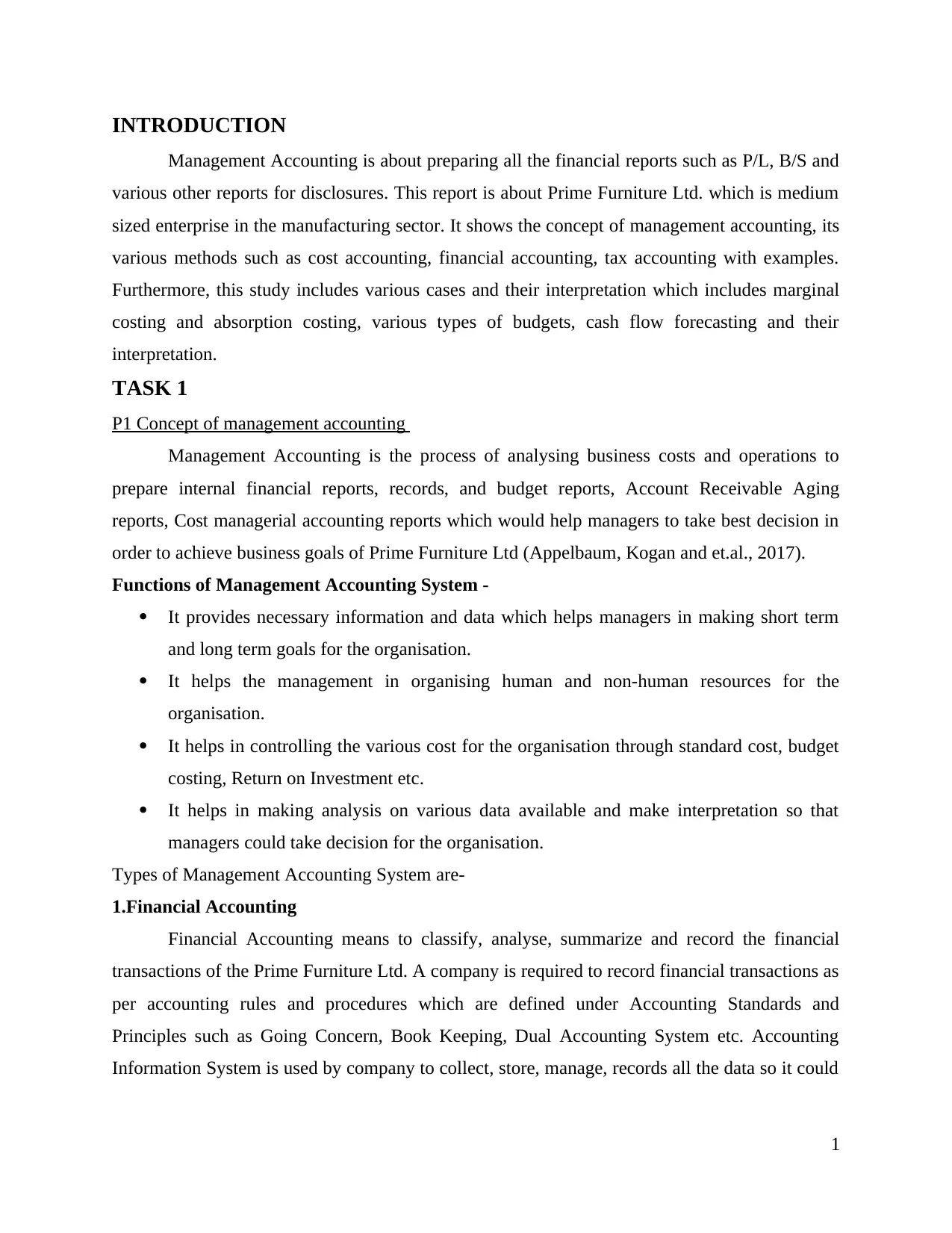
INTRODUCTION
Management Accounting is about preparing all the financial reports such as P/L, B/S and
various other reports for disclosures. This report is about Prime Furniture Ltd. which is medium
sized enterprise in the manufacturing sector. It shows the concept of management accounting, its
various methods such as cost accounting, financial accounting, tax accounting with examples.
Furthermore, this study includes various cases and their interpretation which includes marginal
costing and absorption costing, various types of budgets, cash flow forecasting and their
interpretation.
TASK 1
P1 Concept of management accounting
Management Accounting is the process of analysing business costs and operations to
prepare internal financial reports, records, and budget reports, Account Receivable Aging
reports, Cost managerial accounting reports which would help managers to take best decision in
order to achieve business goals of Prime Furniture Ltd (Appelbaum, Kogan and et.al., 2017).
Functions of Management Accounting System -
It provides necessary information and data which helps managers in making short term
and long term goals for the organisation.
It helps the management in organising human and non-human resources for the
organisation.
It helps in controlling the various cost for the organisation through standard cost, budget
costing, Return on Investment etc.
It helps in making analysis on various data available and make interpretation so that
managers could take decision for the organisation.
Types of Management Accounting System are-
1.Financial Accounting
Financial Accounting means to classify, analyse, summarize and record the financial
transactions of the Prime Furniture Ltd. A company is required to record financial transactions as
per accounting rules and procedures which are defined under Accounting Standards and
Principles such as Going Concern, Book Keeping, Dual Accounting System etc. Accounting
Information System is used by company to collect, store, manage, records all the data so it could
1
Management Accounting is about preparing all the financial reports such as P/L, B/S and
various other reports for disclosures. This report is about Prime Furniture Ltd. which is medium
sized enterprise in the manufacturing sector. It shows the concept of management accounting, its
various methods such as cost accounting, financial accounting, tax accounting with examples.
Furthermore, this study includes various cases and their interpretation which includes marginal
costing and absorption costing, various types of budgets, cash flow forecasting and their
interpretation.
TASK 1
P1 Concept of management accounting
Management Accounting is the process of analysing business costs and operations to
prepare internal financial reports, records, and budget reports, Account Receivable Aging
reports, Cost managerial accounting reports which would help managers to take best decision in
order to achieve business goals of Prime Furniture Ltd (Appelbaum, Kogan and et.al., 2017).
Functions of Management Accounting System -
It provides necessary information and data which helps managers in making short term
and long term goals for the organisation.
It helps the management in organising human and non-human resources for the
organisation.
It helps in controlling the various cost for the organisation through standard cost, budget
costing, Return on Investment etc.
It helps in making analysis on various data available and make interpretation so that
managers could take decision for the organisation.
Types of Management Accounting System are-
1.Financial Accounting
Financial Accounting means to classify, analyse, summarize and record the financial
transactions of the Prime Furniture Ltd. A company is required to record financial transactions as
per accounting rules and procedures which are defined under Accounting Standards and
Principles such as Going Concern, Book Keeping, Dual Accounting System etc. Accounting
Information System is used by company to collect, store, manage, records all the data so it could
1
⊘ This is a preview!⊘
Do you want full access?
Subscribe today to unlock all pages.

Trusted by 1+ million students worldwide
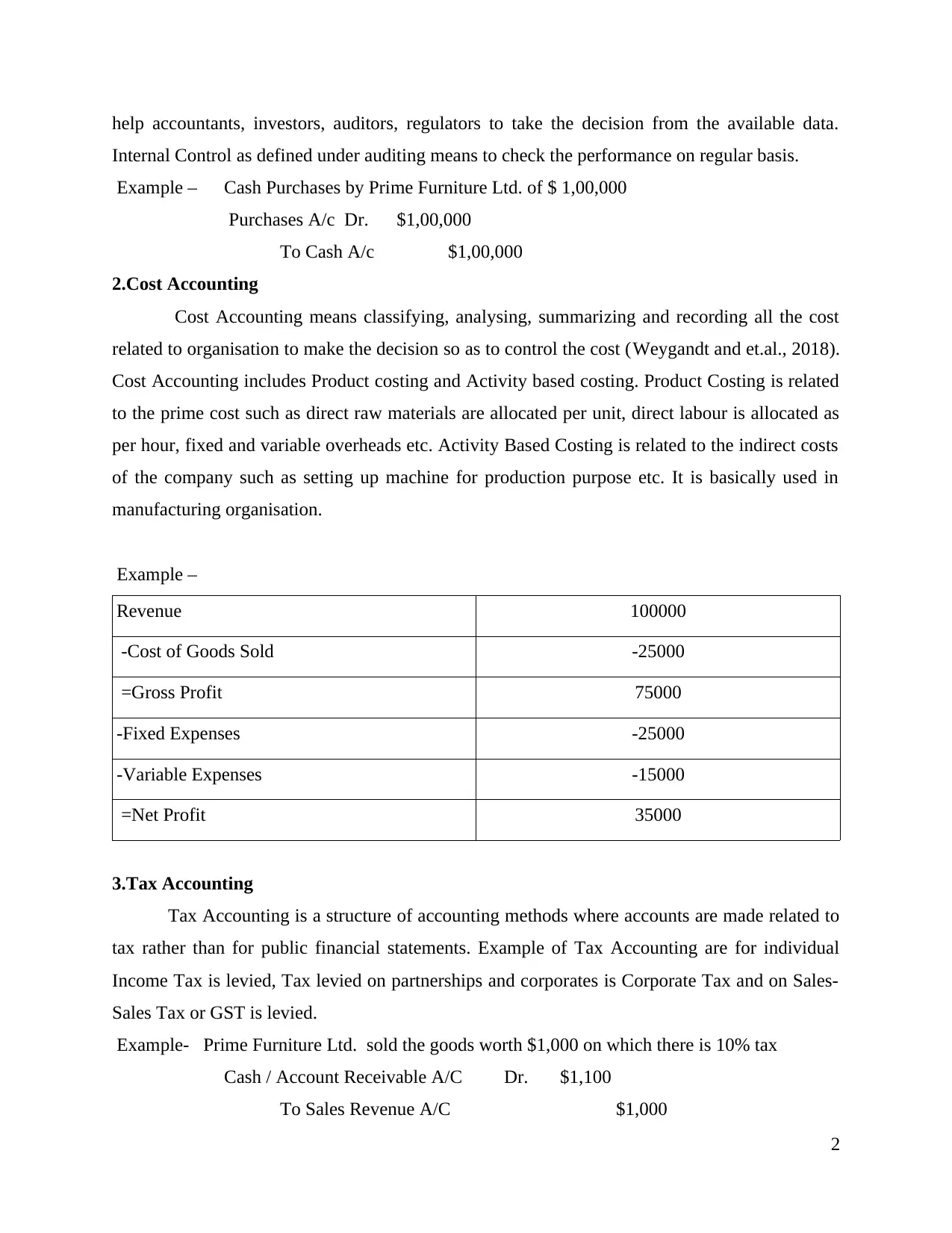
help accountants, investors, auditors, regulators to take the decision from the available data.
Internal Control as defined under auditing means to check the performance on regular basis.
Example – Cash Purchases by Prime Furniture Ltd. of $ 1,00,000
Purchases A/c Dr. $1,00,000
To Cash A/c $1,00,000
2.Cost Accounting
Cost Accounting means classifying, analysing, summarizing and recording all the cost
related to organisation to make the decision so as to control the cost (Weygandt and et.al., 2018).
Cost Accounting includes Product costing and Activity based costing. Product Costing is related
to the prime cost such as direct raw materials are allocated per unit, direct labour is allocated as
per hour, fixed and variable overheads etc. Activity Based Costing is related to the indirect costs
of the company such as setting up machine for production purpose etc. It is basically used in
manufacturing organisation.
Example –
Revenue 100000
-Cost of Goods Sold -25000
=Gross Profit 75000
-Fixed Expenses -25000
-Variable Expenses -15000
=Net Profit 35000
3.Tax Accounting
Tax Accounting is a structure of accounting methods where accounts are made related to
tax rather than for public financial statements. Example of Tax Accounting are for individual
Income Tax is levied, Tax levied on partnerships and corporates is Corporate Tax and on Sales-
Sales Tax or GST is levied.
Example- Prime Furniture Ltd. sold the goods worth $1,000 on which there is 10% tax
Cash / Account Receivable A/C Dr. $1,100
To Sales Revenue A/C $1,000
2
Internal Control as defined under auditing means to check the performance on regular basis.
Example – Cash Purchases by Prime Furniture Ltd. of $ 1,00,000
Purchases A/c Dr. $1,00,000
To Cash A/c $1,00,000
2.Cost Accounting
Cost Accounting means classifying, analysing, summarizing and recording all the cost
related to organisation to make the decision so as to control the cost (Weygandt and et.al., 2018).
Cost Accounting includes Product costing and Activity based costing. Product Costing is related
to the prime cost such as direct raw materials are allocated per unit, direct labour is allocated as
per hour, fixed and variable overheads etc. Activity Based Costing is related to the indirect costs
of the company such as setting up machine for production purpose etc. It is basically used in
manufacturing organisation.
Example –
Revenue 100000
-Cost of Goods Sold -25000
=Gross Profit 75000
-Fixed Expenses -25000
-Variable Expenses -15000
=Net Profit 35000
3.Tax Accounting
Tax Accounting is a structure of accounting methods where accounts are made related to
tax rather than for public financial statements. Example of Tax Accounting are for individual
Income Tax is levied, Tax levied on partnerships and corporates is Corporate Tax and on Sales-
Sales Tax or GST is levied.
Example- Prime Furniture Ltd. sold the goods worth $1,000 on which there is 10% tax
Cash / Account Receivable A/C Dr. $1,100
To Sales Revenue A/C $1,000
2
Paraphrase This Document
Need a fresh take? Get an instant paraphrase of this document with our AI Paraphraser
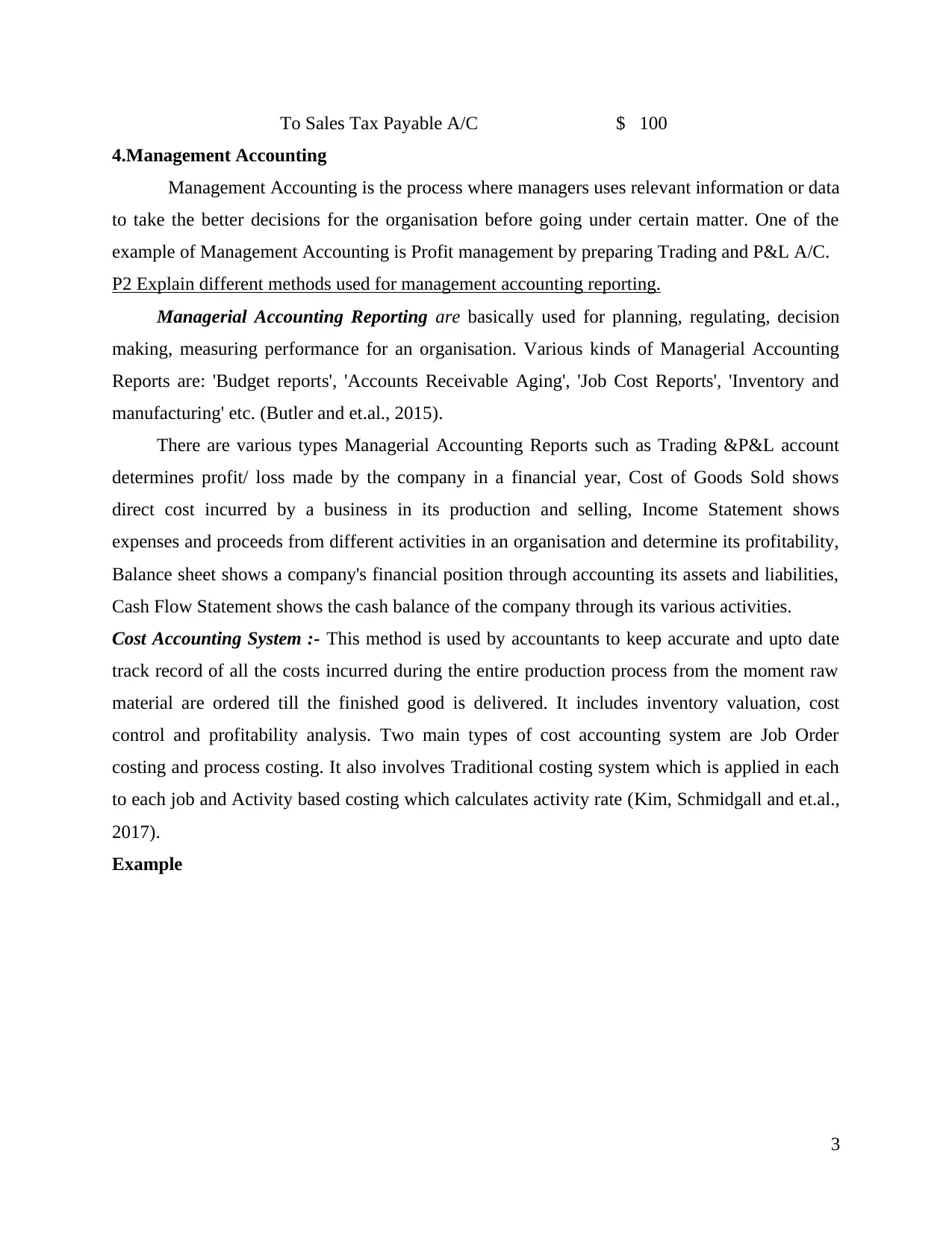
To Sales Tax Payable A/C $ 100
4.Management Accounting
Management Accounting is the process where managers uses relevant information or data
to take the better decisions for the organisation before going under certain matter. One of the
example of Management Accounting is Profit management by preparing Trading and P&L A/C.
P2 Explain different methods used for management accounting reporting.
Managerial Accounting Reporting are basically used for planning, regulating, decision
making, measuring performance for an organisation. Various kinds of Managerial Accounting
Reports are: 'Budget reports', 'Accounts Receivable Aging', 'Job Cost Reports', 'Inventory and
manufacturing' etc. (Butler and et.al., 2015).
There are various types Managerial Accounting Reports such as Trading &P&L account
determines profit/ loss made by the company in a financial year, Cost of Goods Sold shows
direct cost incurred by a business in its production and selling, Income Statement shows
expenses and proceeds from different activities in an organisation and determine its profitability,
Balance sheet shows a company's financial position through accounting its assets and liabilities,
Cash Flow Statement shows the cash balance of the company through its various activities.
Cost Accounting System :- This method is used by accountants to keep accurate and upto date
track record of all the costs incurred during the entire production process from the moment raw
material are ordered till the finished good is delivered. It includes inventory valuation, cost
control and profitability analysis. Two main types of cost accounting system are Job Order
costing and process costing. It also involves Traditional costing system which is applied in each
to each job and Activity based costing which calculates activity rate (Kim, Schmidgall and et.al.,
2017).
Example
3
4.Management Accounting
Management Accounting is the process where managers uses relevant information or data
to take the better decisions for the organisation before going under certain matter. One of the
example of Management Accounting is Profit management by preparing Trading and P&L A/C.
P2 Explain different methods used for management accounting reporting.
Managerial Accounting Reporting are basically used for planning, regulating, decision
making, measuring performance for an organisation. Various kinds of Managerial Accounting
Reports are: 'Budget reports', 'Accounts Receivable Aging', 'Job Cost Reports', 'Inventory and
manufacturing' etc. (Butler and et.al., 2015).
There are various types Managerial Accounting Reports such as Trading &P&L account
determines profit/ loss made by the company in a financial year, Cost of Goods Sold shows
direct cost incurred by a business in its production and selling, Income Statement shows
expenses and proceeds from different activities in an organisation and determine its profitability,
Balance sheet shows a company's financial position through accounting its assets and liabilities,
Cash Flow Statement shows the cash balance of the company through its various activities.
Cost Accounting System :- This method is used by accountants to keep accurate and upto date
track record of all the costs incurred during the entire production process from the moment raw
material are ordered till the finished good is delivered. It includes inventory valuation, cost
control and profitability analysis. Two main types of cost accounting system are Job Order
costing and process costing. It also involves Traditional costing system which is applied in each
to each job and Activity based costing which calculates activity rate (Kim, Schmidgall and et.al.,
2017).
Example
3
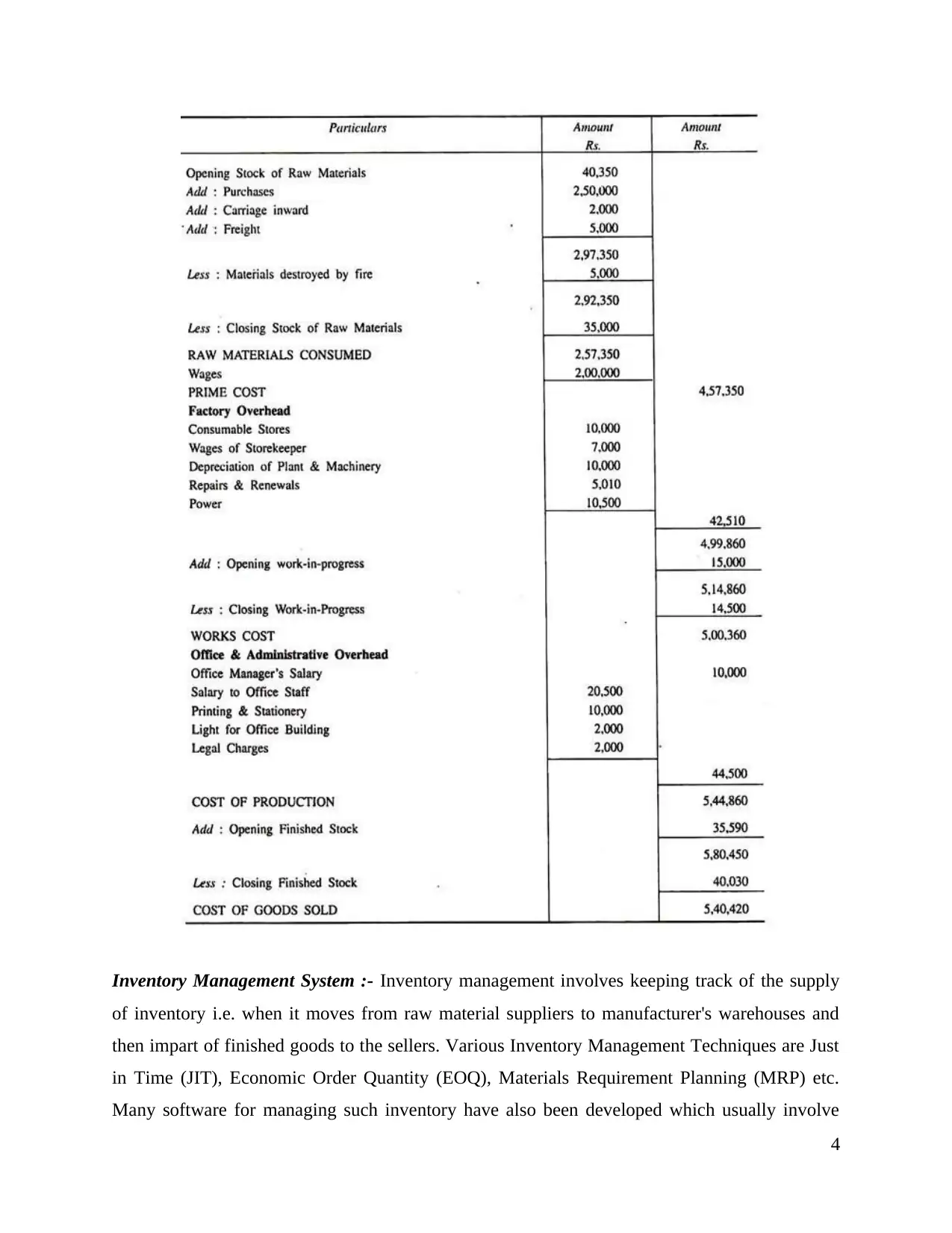
Inventory Management System :- Inventory management involves keeping track of the supply
of inventory i.e. when it moves from raw material suppliers to manufacturer's warehouses and
then impart of finished goods to the sellers. Various Inventory Management Techniques are Just
in Time (JIT), Economic Order Quantity (EOQ), Materials Requirement Planning (MRP) etc.
Many software for managing such inventory have also been developed which usually involve
4
of inventory i.e. when it moves from raw material suppliers to manufacturer's warehouses and
then impart of finished goods to the sellers. Various Inventory Management Techniques are Just
in Time (JIT), Economic Order Quantity (EOQ), Materials Requirement Planning (MRP) etc.
Many software for managing such inventory have also been developed which usually involve
4
⊘ This is a preview!⊘
Do you want full access?
Subscribe today to unlock all pages.

Trusted by 1+ million students worldwide
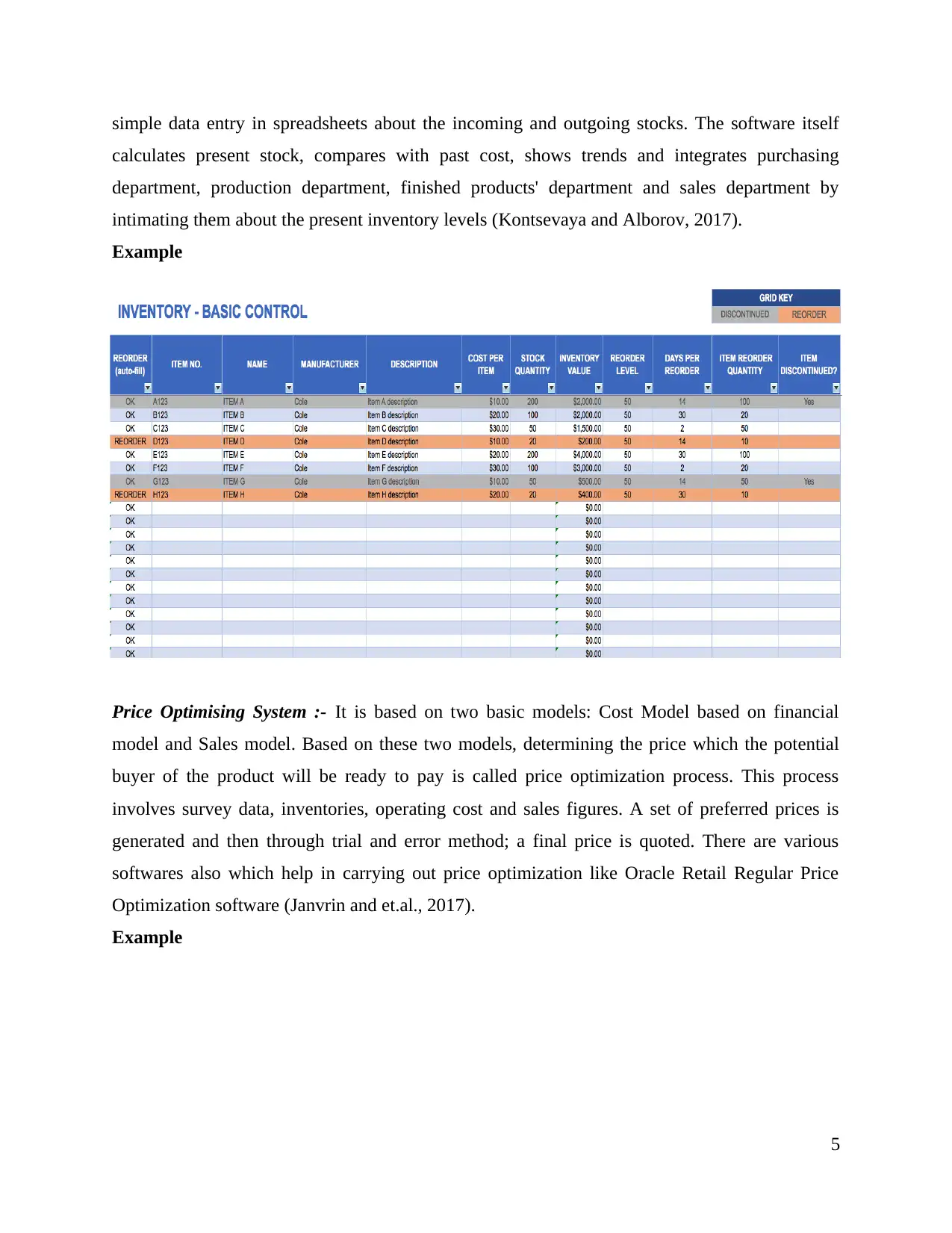
simple data entry in spreadsheets about the incoming and outgoing stocks. The software itself
calculates present stock, compares with past cost, shows trends and integrates purchasing
department, production department, finished products' department and sales department by
intimating them about the present inventory levels (Kontsevaya and Alborov, 2017).
Example
Price Optimising System :- It is based on two basic models: Cost Model based on financial
model and Sales model. Based on these two models, determining the price which the potential
buyer of the product will be ready to pay is called price optimization process. This process
involves survey data, inventories, operating cost and sales figures. A set of preferred prices is
generated and then through trial and error method; a final price is quoted. There are various
softwares also which help in carrying out price optimization like Oracle Retail Regular Price
Optimization software (Janvrin and et.al., 2017).
Example
5
calculates present stock, compares with past cost, shows trends and integrates purchasing
department, production department, finished products' department and sales department by
intimating them about the present inventory levels (Kontsevaya and Alborov, 2017).
Example
Price Optimising System :- It is based on two basic models: Cost Model based on financial
model and Sales model. Based on these two models, determining the price which the potential
buyer of the product will be ready to pay is called price optimization process. This process
involves survey data, inventories, operating cost and sales figures. A set of preferred prices is
generated and then through trial and error method; a final price is quoted. There are various
softwares also which help in carrying out price optimization like Oracle Retail Regular Price
Optimization software (Janvrin and et.al., 2017).
Example
5
Paraphrase This Document
Need a fresh take? Get an instant paraphrase of this document with our AI Paraphraser
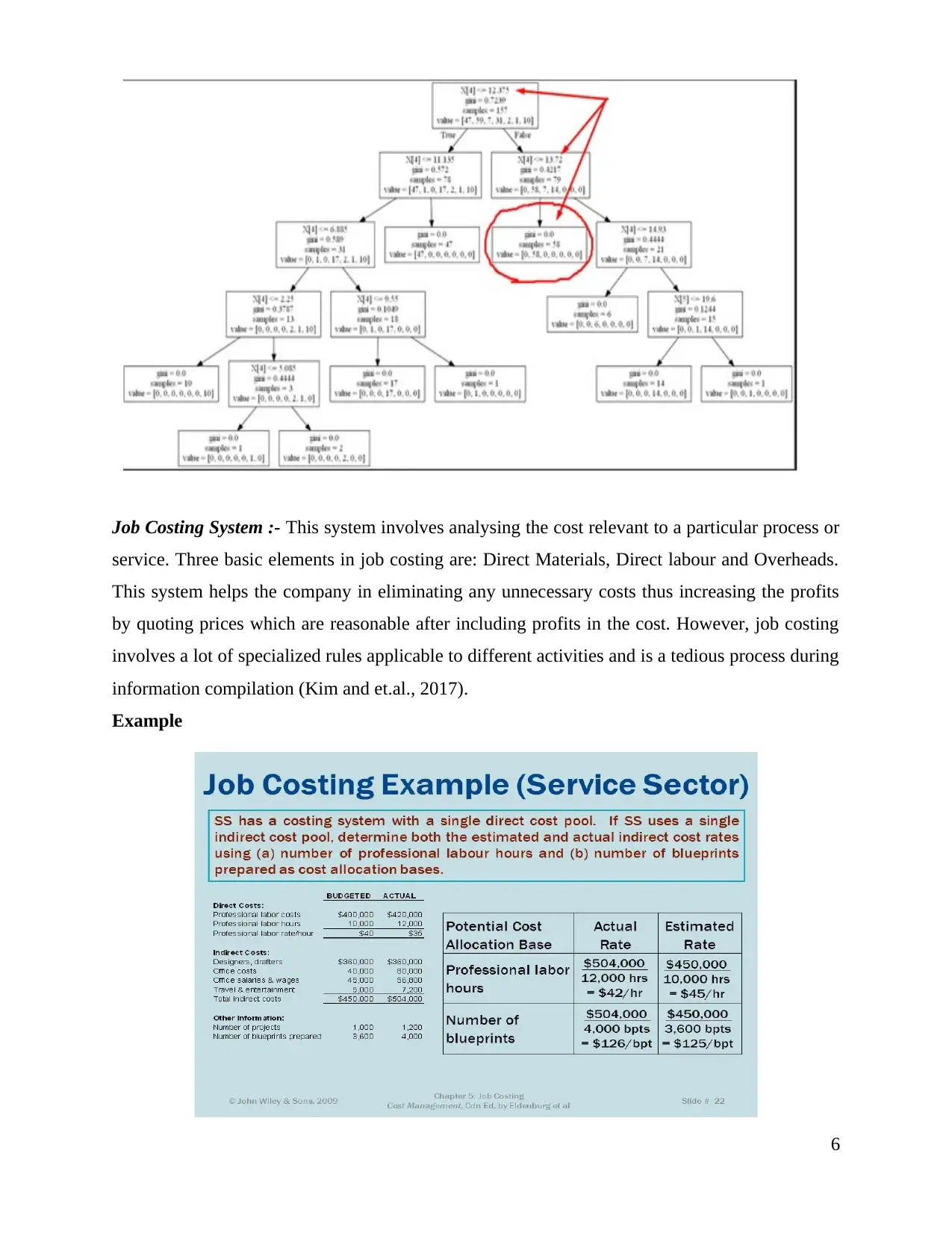
Job Costing System :- This system involves analysing the cost relevant to a particular process or
service. Three basic elements in job costing are: Direct Materials, Direct labour and Overheads.
This system helps the company in eliminating any unnecessary costs thus increasing the profits
by quoting prices which are reasonable after including profits in the cost. However, job costing
involves a lot of specialized rules applicable to different activities and is a tedious process during
information compilation (Kim and et.al., 2017).
Example
6
service. Three basic elements in job costing are: Direct Materials, Direct labour and Overheads.
This system helps the company in eliminating any unnecessary costs thus increasing the profits
by quoting prices which are reasonable after including profits in the cost. However, job costing
involves a lot of specialized rules applicable to different activities and is a tedious process during
information compilation (Kim and et.al., 2017).
Example
6
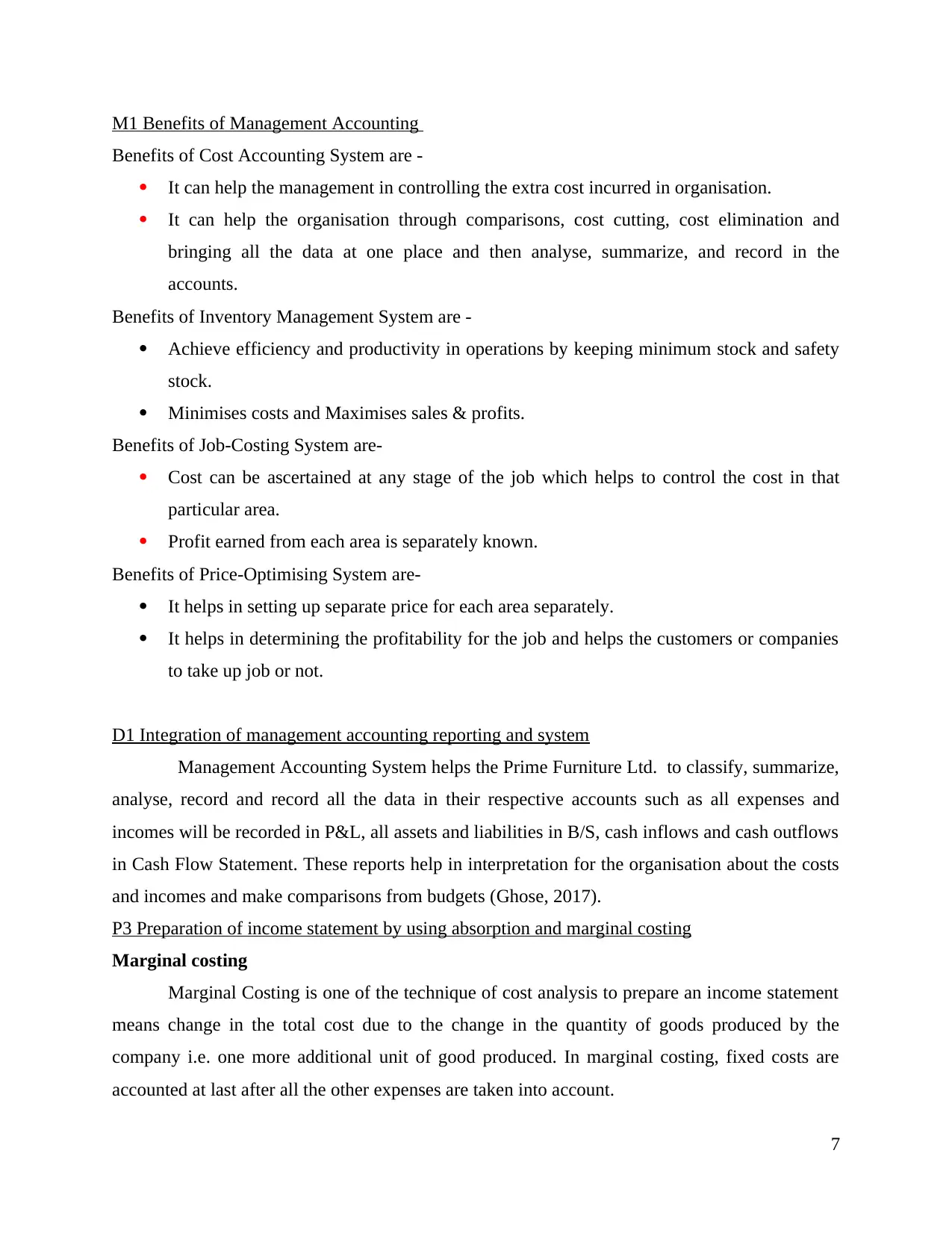
M1 Benefits of Management Accounting
Benefits of Cost Accounting System are -
It can help the management in controlling the extra cost incurred in organisation.
It can help the organisation through comparisons, cost cutting, cost elimination and
bringing all the data at one place and then analyse, summarize, and record in the
accounts.
Benefits of Inventory Management System are -
Achieve efficiency and productivity in operations by keeping minimum stock and safety
stock.
Minimises costs and Maximises sales & profits.
Benefits of Job-Costing System are-
Cost can be ascertained at any stage of the job which helps to control the cost in that
particular area.
Profit earned from each area is separately known.
Benefits of Price-Optimising System are-
It helps in setting up separate price for each area separately.
It helps in determining the profitability for the job and helps the customers or companies
to take up job or not.
D1 Integration of management accounting reporting and system
Management Accounting System helps the Prime Furniture Ltd. to classify, summarize,
analyse, record and record all the data in their respective accounts such as all expenses and
incomes will be recorded in P&L, all assets and liabilities in B/S, cash inflows and cash outflows
in Cash Flow Statement. These reports help in interpretation for the organisation about the costs
and incomes and make comparisons from budgets (Ghose, 2017).
P3 Preparation of income statement by using absorption and marginal costing
Marginal costing
Marginal Costing is one of the technique of cost analysis to prepare an income statement
means change in the total cost due to the change in the quantity of goods produced by the
company i.e. one more additional unit of good produced. In marginal costing, fixed costs are
accounted at last after all the other expenses are taken into account.
7
Benefits of Cost Accounting System are -
It can help the management in controlling the extra cost incurred in organisation.
It can help the organisation through comparisons, cost cutting, cost elimination and
bringing all the data at one place and then analyse, summarize, and record in the
accounts.
Benefits of Inventory Management System are -
Achieve efficiency and productivity in operations by keeping minimum stock and safety
stock.
Minimises costs and Maximises sales & profits.
Benefits of Job-Costing System are-
Cost can be ascertained at any stage of the job which helps to control the cost in that
particular area.
Profit earned from each area is separately known.
Benefits of Price-Optimising System are-
It helps in setting up separate price for each area separately.
It helps in determining the profitability for the job and helps the customers or companies
to take up job or not.
D1 Integration of management accounting reporting and system
Management Accounting System helps the Prime Furniture Ltd. to classify, summarize,
analyse, record and record all the data in their respective accounts such as all expenses and
incomes will be recorded in P&L, all assets and liabilities in B/S, cash inflows and cash outflows
in Cash Flow Statement. These reports help in interpretation for the organisation about the costs
and incomes and make comparisons from budgets (Ghose, 2017).
P3 Preparation of income statement by using absorption and marginal costing
Marginal costing
Marginal Costing is one of the technique of cost analysis to prepare an income statement
means change in the total cost due to the change in the quantity of goods produced by the
company i.e. one more additional unit of good produced. In marginal costing, fixed costs are
accounted at last after all the other expenses are taken into account.
7
⊘ This is a preview!⊘
Do you want full access?
Subscribe today to unlock all pages.

Trusted by 1+ million students worldwide
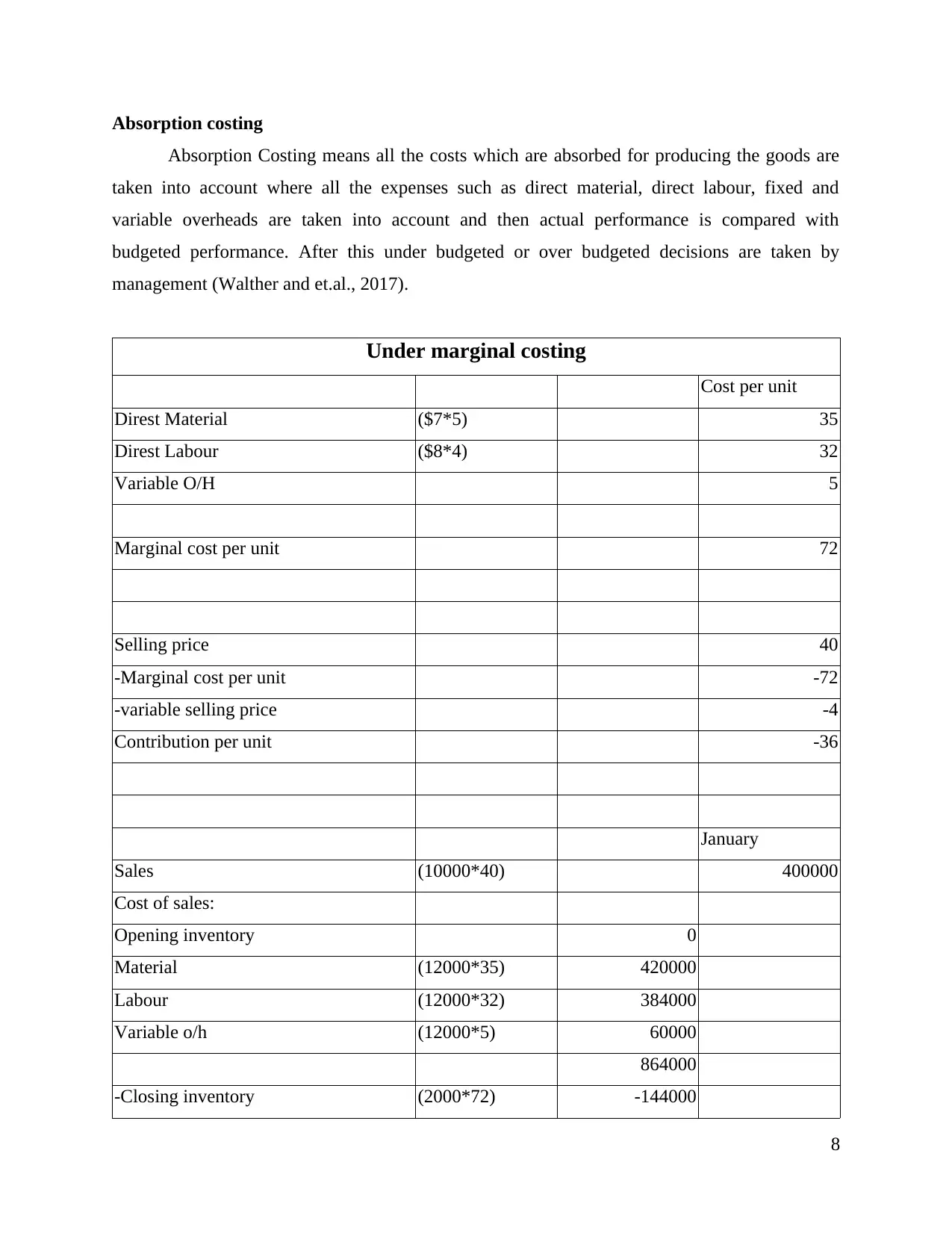
Absorption costing
Absorption Costing means all the costs which are absorbed for producing the goods are
taken into account where all the expenses such as direct material, direct labour, fixed and
variable overheads are taken into account and then actual performance is compared with
budgeted performance. After this under budgeted or over budgeted decisions are taken by
management (Walther and et.al., 2017).
Under marginal costing
Cost per unit
Direst Material ($7*5) 35
Direst Labour ($8*4) 32
Variable O/H 5
Marginal cost per unit 72
Selling price 40
-Marginal cost per unit -72
-variable selling price -4
Contribution per unit -36
January
Sales (10000*40) 400000
Cost of sales:
Opening inventory 0
Material (12000*35) 420000
Labour (12000*32) 384000
Variable o/h (12000*5) 60000
864000
-Closing inventory (2000*72) -144000
8
Absorption Costing means all the costs which are absorbed for producing the goods are
taken into account where all the expenses such as direct material, direct labour, fixed and
variable overheads are taken into account and then actual performance is compared with
budgeted performance. After this under budgeted or over budgeted decisions are taken by
management (Walther and et.al., 2017).
Under marginal costing
Cost per unit
Direst Material ($7*5) 35
Direst Labour ($8*4) 32
Variable O/H 5
Marginal cost per unit 72
Selling price 40
-Marginal cost per unit -72
-variable selling price -4
Contribution per unit -36
January
Sales (10000*40) 400000
Cost of sales:
Opening inventory 0
Material (12000*35) 420000
Labour (12000*32) 384000
Variable o/h (12000*5) 60000
864000
-Closing inventory (2000*72) -144000
8
Paraphrase This Document
Need a fresh take? Get an instant paraphrase of this document with our AI Paraphraser
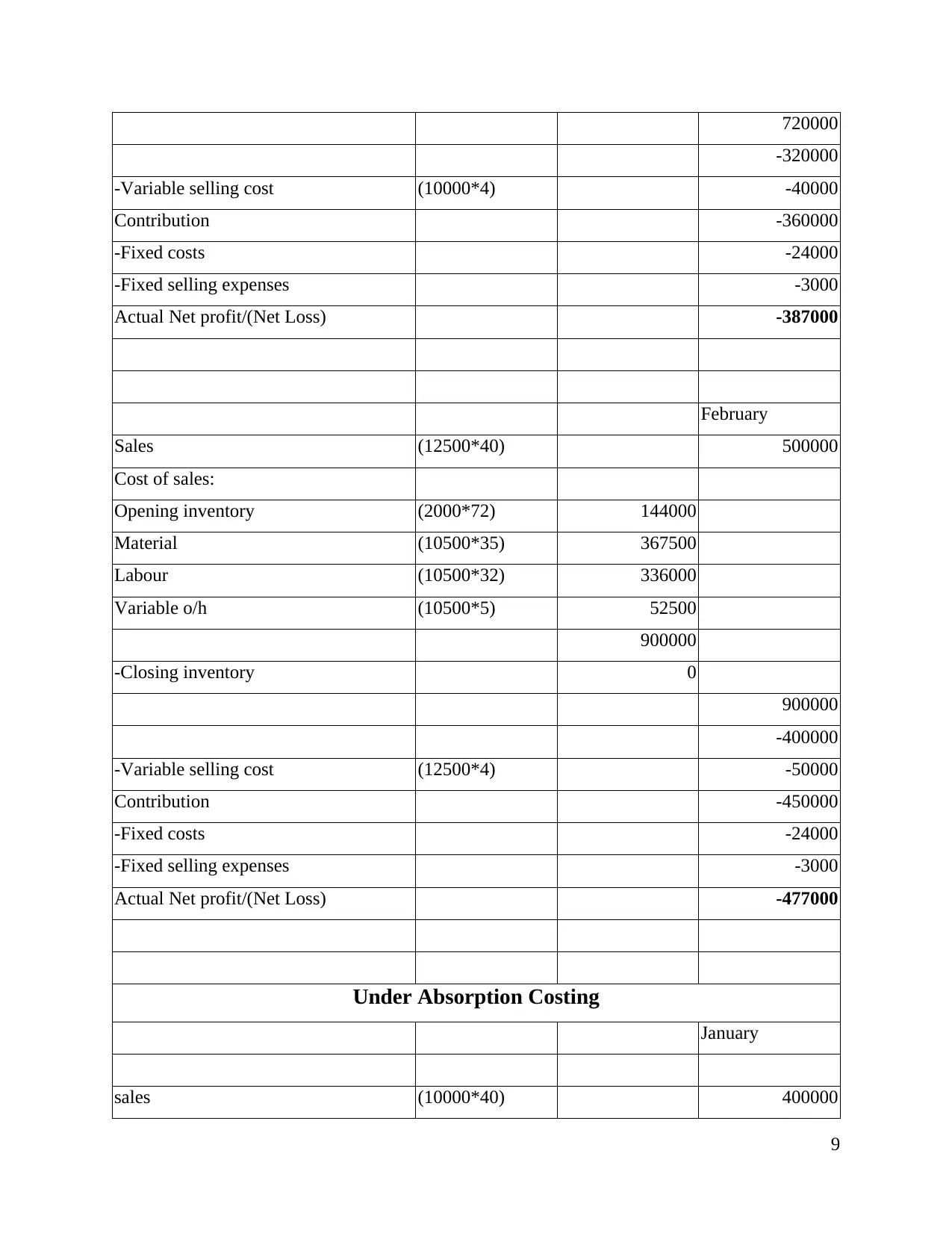
720000
-320000
-Variable selling cost (10000*4) -40000
Contribution -360000
-Fixed costs -24000
-Fixed selling expenses -3000
Actual Net profit/(Net Loss) -387000
February
Sales (12500*40) 500000
Cost of sales:
Opening inventory (2000*72) 144000
Material (10500*35) 367500
Labour (10500*32) 336000
Variable o/h (10500*5) 52500
900000
-Closing inventory 0
900000
-400000
-Variable selling cost (12500*4) -50000
Contribution -450000
-Fixed costs -24000
-Fixed selling expenses -3000
Actual Net profit/(Net Loss) -477000
Under Absorption Costing
January
sales (10000*40) 400000
9
-320000
-Variable selling cost (10000*4) -40000
Contribution -360000
-Fixed costs -24000
-Fixed selling expenses -3000
Actual Net profit/(Net Loss) -387000
February
Sales (12500*40) 500000
Cost of sales:
Opening inventory (2000*72) 144000
Material (10500*35) 367500
Labour (10500*32) 336000
Variable o/h (10500*5) 52500
900000
-Closing inventory 0
900000
-400000
-Variable selling cost (12500*4) -50000
Contribution -450000
-Fixed costs -24000
-Fixed selling expenses -3000
Actual Net profit/(Net Loss) -477000
Under Absorption Costing
January
sales (10000*40) 400000
9
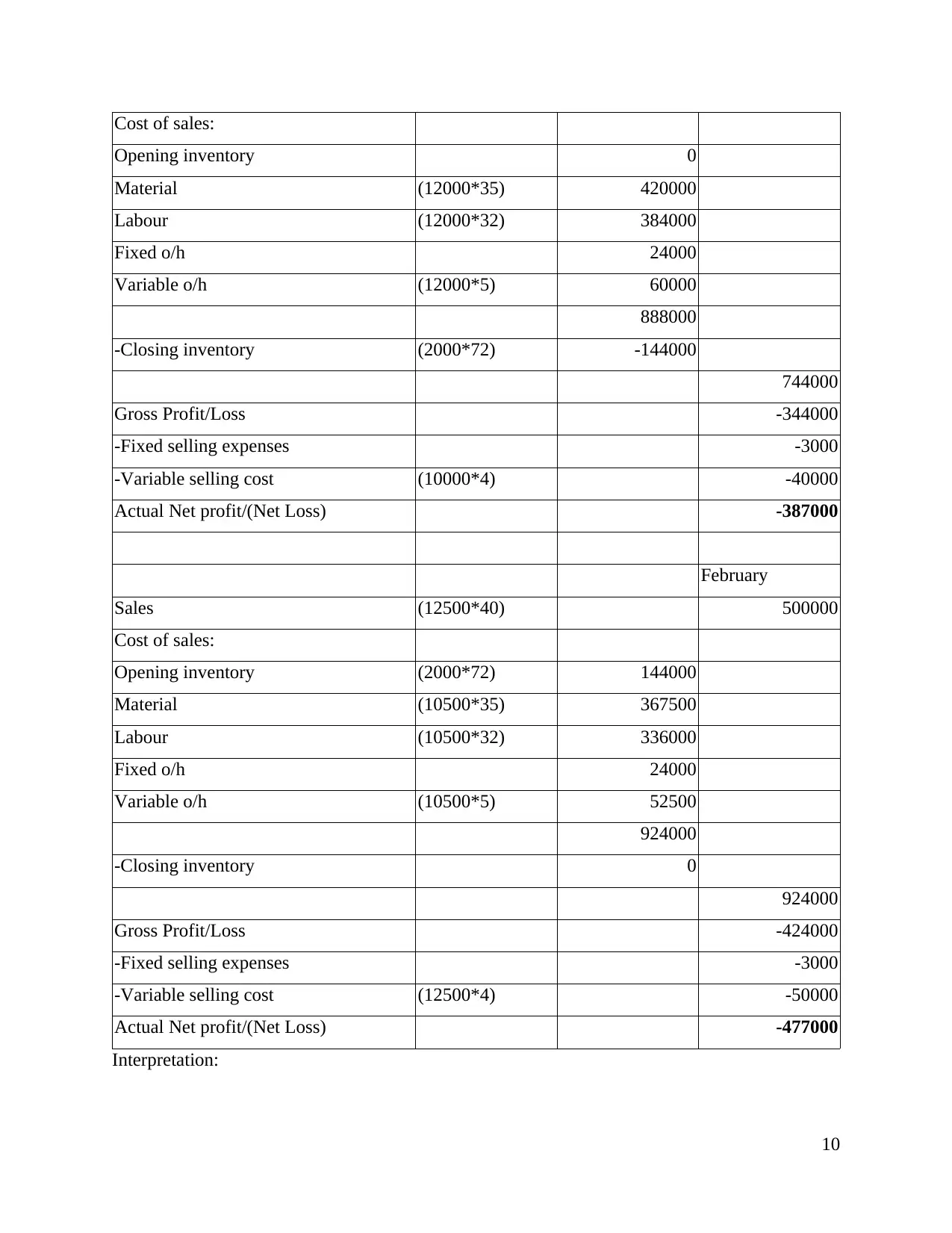
Cost of sales:
Opening inventory 0
Material (12000*35) 420000
Labour (12000*32) 384000
Fixed o/h 24000
Variable o/h (12000*5) 60000
888000
-Closing inventory (2000*72) -144000
744000
Gross Profit/Loss -344000
-Fixed selling expenses -3000
-Variable selling cost (10000*4) -40000
Actual Net profit/(Net Loss) -387000
February
Sales (12500*40) 500000
Cost of sales:
Opening inventory (2000*72) 144000
Material (10500*35) 367500
Labour (10500*32) 336000
Fixed o/h 24000
Variable o/h (10500*5) 52500
924000
-Closing inventory 0
924000
Gross Profit/Loss -424000
-Fixed selling expenses -3000
-Variable selling cost (12500*4) -50000
Actual Net profit/(Net Loss) -477000
Interpretation:
10
Opening inventory 0
Material (12000*35) 420000
Labour (12000*32) 384000
Fixed o/h 24000
Variable o/h (12000*5) 60000
888000
-Closing inventory (2000*72) -144000
744000
Gross Profit/Loss -344000
-Fixed selling expenses -3000
-Variable selling cost (10000*4) -40000
Actual Net profit/(Net Loss) -387000
February
Sales (12500*40) 500000
Cost of sales:
Opening inventory (2000*72) 144000
Material (10500*35) 367500
Labour (10500*32) 336000
Fixed o/h 24000
Variable o/h (10500*5) 52500
924000
-Closing inventory 0
924000
Gross Profit/Loss -424000
-Fixed selling expenses -3000
-Variable selling cost (12500*4) -50000
Actual Net profit/(Net Loss) -477000
Interpretation:
10
⊘ This is a preview!⊘
Do you want full access?
Subscribe today to unlock all pages.

Trusted by 1+ million students worldwide
1 out of 19
Related Documents
Your All-in-One AI-Powered Toolkit for Academic Success.
+13062052269
info@desklib.com
Available 24*7 on WhatsApp / Email
![[object Object]](/_next/static/media/star-bottom.7253800d.svg)
Unlock your academic potential
Copyright © 2020–2025 A2Z Services. All Rights Reserved. Developed and managed by ZUCOL.





